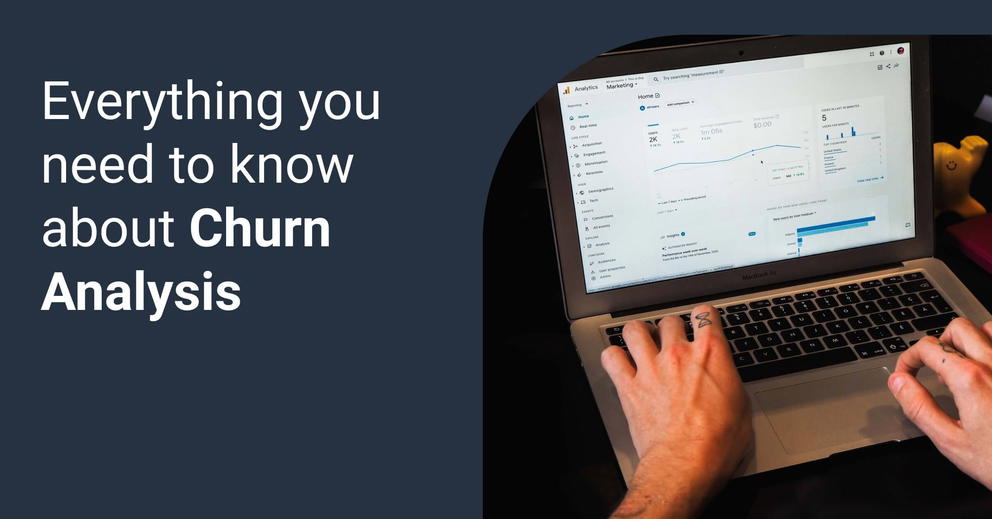Everything you need to know about Churn Analysis
Before diving head-first into the complexities of Churn analysis and the different models used to measure customer churns, it would probably do you good to understand what churn analysis is. Customer retention helps brands grow. To retain customers, it is important to understand why they would leave in the first place. This is what customer churn analysis is all about.

Apr 21 2021 ● 4 min read

What is Churn?
Churn refers to the percentage of customers that decline the use of subscriptions or products within a fixed time frame. It is also known as customer attrition. Businesses focus on growth so that they make good returns. For subscription-based businesses, this means having new customers who are signing on to use their services. It also requires keeping existing customers for as long as possible.
Inevitably, some customers are likely to churn for a myriad of reasons. Churn reveals the percentage of cancellations, as well as customers that do not renew subscriptions. For businesses, churn enables measuring the satisfaction that a customer has for a product or a service.
What is a Churn Model?
To simplify decision-making, a churn model should be used. This type of model can combine the different types of insights and outputs. The information presented can then be used for making decisions for the business.
The output of a churn model can help with churn prediction. This output reveals whether there is the risk of a customer canceling their subscription in the future. Risk scores can be applied when seeking to develop user retention campaigns.
These campaigns can ignite sharing of information with customers through email. With the model, it becomes easier to flag long-term customers who may churn, thus encouraging them to retain their subscriptions.
Why would a customer churn?
Subscriptions or similar services are typically voluntary. Customers have a problem, and the subscription fills the gap. Therefore, letting go of the subscription means that something may not be right. There are several reasons for customer churn as follows:
Dissatisfaction
A negative experience could lead to customer churn. The is because the customer becomes unhappy with using the product. With apps, for example, this may be as a result of dismal features, challenges with usability, or even continuous bugs.
Competition
Competitors may introduce a product that is more attractive to the customer. This results in a switch as an alternate solution that may lower costs or deliver a better experience.
Lack of Functionality
The subscription lacks a specific function that the customer requires. Another scenario is that the customer cannot figure out how to maximize their use of the subscription.
Cost
Existing customers may not be able to afford the product. The company offering the subscription may change its pricing. This may catch customers off guard or lead the product to shift from affordable to expensive.
Value
The key motivation a customer has for using a product may no longer be there. This means that the customer loses value in the subscription and thus amends their priorities.
Problem Solved
A customer may choose a subscription to address a specific need. Once that need has been met, the subscription may no longer be necessary.
Security
The reputation of the company offering a subscription is crucial. A bad reputation, particularly with data safety, lack of customer service, or scandal, can result in customer churn.
Devise Storage
This is applicable for subscriptions that may be accessed on mobile devices, or which require downloads. The customer may cancel the subscription if they feel it is taking up too much storage space.
Customers can churn at any time, and analytics of customer churn is crucial to business success. A customer may choose to churn within the same month that they subscribe for a product or service, which can impact the churn analysis. Churn analysis requires an understanding of the customer, company, competition, and other factors.
How do you identify customers' churns?
Identifying churns requires looking within and outside of the business. This will determine whether the churn was contractual, non-contractual, voluntary, or involuntary. When it's contractual, a customer will pay for their subscriptions or products at specific intervals. These are normally automatically paid, such as cable tv subscriptions. Churns are quite clear with contractual agreements.
With non-contractual agreements, there is more flexibility. The customer may choose to purchase or subscribe when it is most convenient for them. This may be the case with an online shoe store. Determining when a churn has taken place is more challenging due to customer inconsistency.
Voluntary churns occur when a customer chooses to stop their subscription or purchase. A churn is involuntary when the customer is forced to discontinue the service. This may occur as a result of credit card expiry.
The first step is understanding the type of churn. Next, user behaviour, internal, and external factors could be the cause of the churn.
When there is a rise in cancelled subscriptions, it may indicate something wrong with the product. Evaluating customer feedback and comments will reveal if this is the case. It is also important for the business to pay attention to what is happening with the competition. A new competitor offering or different pricing can result in customers' migration and a high churn.
In some cases, customers stop renewing their subscriptions. This could be an indication of an internal issue, particularly with customer service. Without the right engagement, it becomes easy for customers to drift away.
Finally, a customer may stop their subscription, even though the business has done everything possible to accommodate them. This may be an indication that it is time to expand your products or elevate your value.
Why should businesses calculate churn?
Acquiring new customers is much more expensive than retaining existing ones. Losing customers also have an adverse effect on growth for the company. A business or product can't have a churn rate of 0%. However, it is possible to reduce churn down to become as low as possible.
Churn is also a high cost for any business. Research reveals that getting a new customer can cost up to five times as retaining a customer. Churns limits the ability of the company to compete effectively. This is because rather than coming up with new strategies to improve products or services, the focus shifts to getting more customers. Churn limits growth and can be an indication of a growing problem.
To get a clear picture of the churn rate's overall effect, it should be compared with the growth rate. Should the growth rate be higher than the churn rate, it is an indication that the company may still be on the right track. However, if the churn rate is higher than the growth rate, then the company is in danger of experiencing massive losses.
What Is Customer Churn Analysis?
For the customer churn rate to be calculated, the data needs customer churn analysis. There are various ways to do this. To begin with, a simple way to calculate the churn rate is determining the percentage of total customers that are no longer using a subscription after some time.
For example, a business might have 1,000 subscriptions in January. In this month, subscriptions need to renewal. However, the business did not send reminders to customers. One hundred of the customers have their subscriptions cancelled, leaving only 900 customers. This reveals that the churn rate is 10%.
With this information from the customer churn analysis, it is possible to gain some actionable insights. Over time and consistent monitoring, it becomes clear when the drop-off points for subscribers are. This may help with identifying the cause for churn or guide improvement of the user experience.
How do you analyze the churn rate?
The churn rate can fluctuate from one day to another due to a variety of factors. These could be internal factors that affect businesses or external factors. Churn rate analysis should be done at specific periods, such as each month, quarter, or year. This means you need to be clear when you start calculating the churn rate.
Here is an example. A business has 1,000 customers in January. At the beginning of the month, they had a total of 800 customers. This means that by the end of the month, they had an additional 200 customers. If 100 customers stop their subscriptions, it means that their month ends with 900 customers. This would increase the churn rate to 11.1%.
Given this example and the earlier one, it becomes clear that the churn's exact moment needs to be determined. Subscriptions cancellation and the subscription expiring are the two times that customers churn.
The customer churns analysis results will differ from one company to another, even if it looks the same. In the customer churn analysis process, historical data on user behavior should be a reference. This allows for comparison with new customer data to identify patterns.
If you carry out a customer churn analysis and the numbers are high, do not think that something is wrong. Do a comparison with the industry benchmark and see whether the numbers are similar. For example, if the industry churn rate is 12%, even competitors' products may experience drops in their subscriptions. If the industry churn rate by 3%, and the company churn rate 10%, you will have cause for concern.
How can the Churn Rate be Reduced?
The value proposition that is on offer is key to reduce churn rates. Once a customer believes that they gain more value by retaining their subscription, they will experience discomfort if a churn is available. The following will help reduce the churn rate:
Ensure customers maximize usage
Customers need education and traditional or virtual training on all the features of their subscription. For the provider, this means preparing content, including tutorials with step-by-step instructions. It should also be easy to reach out and receive help when necessary.
Customer perception pricing
The way that you price your subscription should be based on customer perception. The customer is not interested in your internal operations, profits, or revenue. At the right price point, more customers will choose to subscribe.
Choose the right customer
Have a working customer profile that outlines who is the best customer for the subscription. This may require looking at messaging to determine whether the right product attributes are highlighted.
Treat every month like new
Over time, and with many subscribers, it is easy to take customers for granted. Each month should be treated as a new month, with actions out in place to retain customers. This requires always evaluating the customer experience and ensuring it is not disrupted.
If it ain’t broke…
There is a saying that goes, if it ain’t broke, don’t fix it. When you upgrade your product or service, ensure that you do not change the functional elements that thrill your customers. Add new features, though do not diminish quality while you are doing so.
Customer churn analysis will give you the data you need to understand why a customer would discontinue the use of your product or service. This data should also drive you to action and become a part of strategic planning. All churn data should be viewed as having the potential to improve business performance.
Published on Apr 21 2021

WRITTEN BY
Vytautas PučkaVytautas is a marketing specialist with experience in Customer Service and Sales. As a data-driven professional, he is excited to have discussions with his readers and debate new and innovative ideas about marketing.